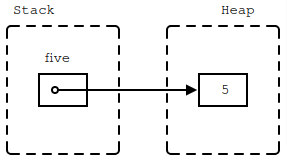Box
Box is an owned pointer to data on the heap:
fn main() {
let five = Box::new(5);
println!("five: {}", *five);
}five: 5
Box<T> implements Deref<Target = T>, which means that you can call methods from T directly on a Box<T>.
Notes
- Box is like std::unique_ptr in C++, except that it’s guaranteed to be not null.
- In the above example, you can even leave out the * in the println! statement thanks to Deref.
- A Box can be useful when you:
- have a type whose size that can’t be known at compile time, but the Rust compiler wants to know an exact size.
- want to transfer ownership of a large amount of data. To avoid copying large amounts of data on the stack, instead store the data on the heap in a Box so only the pointer is moved.
Box with Recursive Data Structures
Recursive data types or data types with dynamic sizes need to use a Box:
#[derive(Debug)]
enum List<T> {
Cons(T, Box<List<T>>),
Nil,
}
fn main() {
let list: List<i32> = List::Cons(1, Box::new(List::Cons(2, Box::new(List::Nil))));
println!("{list:?}");
}Cons(1, Cons(2, Nil)) Notes
Notes
- If Box was not used and we attempted to embed a List directly into the List, the compiler would not compute a fixed size of the struct in memory (List would be of infinite size).
- Box solves this problem as it has the same size as a regular pointer and just points at the next element of the List in the heap.
- Remove the Box in the List definition and show the compiler error. “Recursive with indirection” is a hint you might want to use a Box or reference of some kind, instead of storing a value directly.
Niche Optimization
#[derive(Debug)]
enum List<T> {
Cons(T, Box<List<T>>),
Nil,
}
fn main() {
let list: List<i32> = List::Cons(1, Box::new(List::Cons(2, Box::new(List::Nil))));
println!("{list:?}");
}Cons(1, Cons(2, Nil))A Box cannot be empty, so the pointer is always valid and non-null. This allows the compiler to optimize the memory layout:
